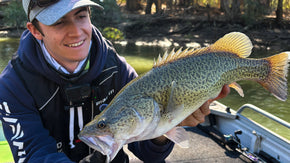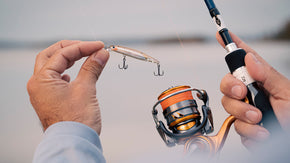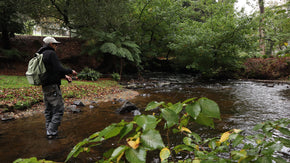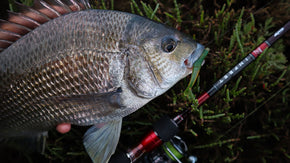Posted 10th February 2023
Landbased Series: Tasmania Region


By Robert Thornton
Tasmania really is a spectacular part of Australia, and any angler who has ever spent time on the apple isle will tell you exactly that. The quality of the fishing is more akin to a tropical paradise than a temperate island on the doorstep of the Southern Ocean. Tassie offers everything from barrel-sized southern bluefin tuna in nutrient-rich seas to wily trout in skinny tussock-lined streams, and of course, a stack of options in between.
Many visiting anglers board the barge in Victoria with a boat in tow, however this blog will show you that a boat isn’t necessary to sample some of the incredible fishing on offer at the bottom of Australia! In fact, you don’t even need to leave the main cities or venture too far off the beaten track to score. Whether it’s the streams, lakes, estuaries or ocean waters you wish to fish, there are plenty of places to do so on foot. Fishing landbased will also give you more time to explore the other attractions in Tassie if you’re visiting, or if you already live there, more time to tend to your everyday obligations.
Landbased fishing is about saving time and money, and using your sense of adventure to find places where you can used being landbased to your advantage. Luckily for you, there are countless areas to throw a line in from the shore, and in this blog we’re going to look at a few Tassie fishing spots, the species in them, plus a few presentations and techniques as well.
 Landbased Kit
Landbased Kit
If you’ve read any of our other blogs in this landbased series, you’ll know how important it is to set yourself up right. Once you have a kit together, it’s much easier to bounce between areas and techniques, as versatility is the key to good landbased fishing.
Having access to a car will help a lot, however Tassie’s public transport networks will also get you to many productive landbased spots. Cyclists can also get around on the many bikeways winding through the cities and towns.
Without a car you are confined to what you can carry in a pack, however you can still set yourself up with more than enough to get by in most places, you just need to pack smartly.
For basic tackle storage options, Daiwa’s Guide Waist Bag and Sling Bag offer very easy and compact storage, perfect for anyone doing lightning fast trips before or after work, school or study. They don’t have to be used just for carrying fishing gear either!
The Trout Shoulder Bag is ideal for anyone chasing introduced salmonids, but also other species as well. With a plier holder, mesh pockets, multiple Velcro pockets, multiple toggles, and a sealed zipper pocket, this bag will keep things safe and protected, but also within easy reach.
If the aim is to carry a bit of extra gear and keep the options open, the Guide Backpack is probably your best bet. Tassie has a lot of areas where walking is the best way to get from spot to spot, making a fishing specific backpack like this invaluable. Additionally, the Guide Backpack, Guide Waist Bag and Guide Phone Pouch can be combined in a bag-on-bag system!
The Soft Plastic Walletand Egi Wallet are handy for keeping your soft plastics and squid jigs organised inside your main bag, as there’s nothing worse than opening up your pack to find everything tangled or even stuck in the material itself!
Landbased Tackle
Daiwa pro staffer and Taswegian Jack Gillespie has lived and fished in the apple isle for a long time, and knows the secrets of its landbased fisheries.
“For an allrounder I’d probably be looking at standard bream gear,” he says, “a spin rod in the 2-4kg range with 6-8lb braid – this is good for bream, trout, whiting, flathead and other things.”
“I use Infeet rods, but the TD Hyper range is a bit more budget friendly.”
Reels in the 2000-3000 size are the best fit for long, light spin rod like these, with Daiwa’s 22 Infeet X reels a great range to take a look at, and the 23 Aird LT better for the angler on a budget.
Keeping rods to a minimum of about 7ft is a good idea, especially if you’re fishing near the coast and occasionally need to send out a longer cast, or if on a windy trout lake. Fishing in the streams for trout may call for a slightly shorter rod, depending on the surrounding vegetation, but generally speaking a 7-7’6” rod should be a fine across the board.
Spooling up with 6-8lb J-Braid Grand will mean you can fish finesse techniques, while still have the pulling power to extract bigger black bream and trout. Leader such as J-Thread Finesse FCare perfect if you’re trying to be stealthy in your approach, as this material is onlyavailable in 3, 4, 5, and 6lb. If you need to upsize, standard J-Thread FC covers everything from 4-80lb.
 Lures
Lures
Given that Tassie fisheries overall endure less angling pressure, lures are still very effective in most places, and Jack likes to take advantage of this.
“Even our busier areas are not that busy at all, compared to other cities around Australia,” he explains.
Jack likes to use a variety of lures, however there are a few from Daiwa’s range that consistently perform for him.
“I definitely like to have a few Bait Junkie 2.5 Inch Grubs on me,” he says, “and plenty of Double Clutches as well in a variety of colours to suit bream and trout.”
“You should have some squid jigs with you too,” he continues, “the squidding here can be pretty good.”
And when jack says “pretty good”, what he means is that Tassie can offer some of the best squidding around the country in terms of the average size!
“I also like to have some crab imitations for bream, as they just love them down here,” he explains.
Tassie Fishing Spots
Tassie has some truly excellent landbased fishing opportunities, and Jack has sampled many of them over the years.
“The bream fishing is as good landbased as it is from a boat,” Jack says, “landbased anglers can potentially catch sizeable fish around the 2kg mark.”
“There’s also trout down here in every patch of freshwater,” he continues, “so any little creek should have trout, with bigger systems generally holding bigger fish.”
 Bread-and-Butter
Bread-and-Butter
There’s plenty of areas to target species such as bream, sea run trout, calamari and whiting all around Tasmania, and in this blog we’ll only mention a few of the many.
“There’s a rocky shore along Old Beach in Hobart, and this is a good spot for bream and sea run trout,” Jack explains, “You can often catch both species in the same session, which is really cool.”
“The stone walls along Bellerive further down the river is a good spot to cast lures for bream.”
“Calamari will also show up around this area too.”
These great options aren’t limited to the Hobart region either, with the many towns scattered around the island’s coastline offering a similar bounty.
“George Town on the North Coast is extremely popular,” he explains, “The Low Head break wall is a great spot for calamari, and a few pelagics as well.”
Pelagics and Larger Predators
Speaking of pelagics, those with the need for speed aren’t forgotten about, with Tassie’s entire coast playing host to a variety of pelagic species. Famous speedsters like southern bluefin tuna and albacore aren’t usually within in reach for the average landlubber, however the migratory salmon and kingfish do come in close enough at times.
“Low Head is a good area for bigger predators like salmon, and the lower parts of the Tamar River is a known hotspot as well,” Jack says, “snapper will sometimes turn up here too.”
“Lots of kingies get caught around the Bridgewater Bridge [in Hobart] in summer, and a good portion of these are taken landbased.”
“Salmon and kingies will also turn up around Bellerive, again mostly during the summer months.”
Bream and trout gear will stand up to smaller pelagics, however any fish over 2-3kg will probably demand heavier tackle. Good quality 3-6kg rods and 3000 size spin reels are more suitable if salmon, snapper and kingies become a more regular target for you.
 Freshwater
Freshwater
The trout fishing in Tasmania is one of the major drawcards for anglers everywhere, and there’s no shortage of places to find rainbow, brown and brook trout. Trout can be found in stream, lake and estuary environments throughout Tassie.
“The Derwent is a productive trout river, even in tidal stretches,” Jack says, “and I reckon they’re catchable probably as far downstream as Otago or Glenorchy.”
“There are some great landbased options around New Norfolk – you can fish around the boat ramp near town and walk a good distance along the river.”
“Lake Crescent is another good spot, and it’s not too far from Hobart,” he continues, “It’s a great lake that you can fish landbased year-round, and it’s probably the most accessible lake in this area.”
“Basically, you can just pull up anywhere and start fishing, there’s nothing in your way.”
The North Coast also has plenty on offer for trout bums, with many good spots sitting very close to major towns in the area.
“Devonport is a good place to base yourself for trout,” Jack says, “there’s just so many rivers in the north and they all hold trout.”
“Near Launceston is Four Spring Lake,” he explains, “and this lake is extremely popular for landbased anglers, and very accessible.”
“Soft plastics are really good in Four Springs, and this lake is known for producing good size fish as well.”
Wrap-up
Finding a good fishing spot in Tassie is simple, and ‘anywhere there’s water’ is as good a rule to follow as any. Wherever you choose to wet a line, taking the time to work out the subtleties and nuances of the fish and their feeding habits there will help you build a picture of how to best fish that spot. It may take a few visits, but after a while it becomes clearer, and you’ll be able to find quality fish on a more regular basis.
If you ever find yourself in Tassie, or currently live there and want to start fishing, don’t discount the landbased options available there. You may just land your PB bream, trout or squid!
















